RBSE Class 12 Biology Important Questions Chapter 5 Principles of Inheritance and Variation
Rajasthan Board RBSE Class 12 Biology Important Questions Chapter 6 Molecular Basis of Inheritance Important Questions and Answers
RBSE Class 12 Biology Chapter 5 Important Question Principles of Inheritance and Variation
Multiple Choice Questions
Question 1.
Mendel studied seven contrasting characters for his breed experiment with Pisum sativum, which of the following character did he not use?
(a) Pod colour
(b) Pod shape
(c) Leaf shap
(d) Plant height
Answer:
(c) Leaf shap

Question 2.
Which one is a dominant trait out of the characters chosen by Mendel?
(a) Pod colour - yellow
(b) Seed colour - yellow
(c) Plant height - dwarf
(d) Flower position - Axillary
Answer:
(d) Flower position - Axillary
Question 3.
When a true breeding tall plant is crossed with a true breeding short plant and F1 produced is self-pollinated to produce F2, ratio of true breeding tall and true breeding short plant is F2 will be :
(a) 1 : 2
(b) 1 : 1
(c) 2 : 1
(d) 1 : 3
Answer:
(b) 1 : 1
Question 4.
Which is connected with multiple phenotypes?
(a) Mutations
(b) Epistatis
(c) Pleiotropy
(d) Polygenic inheritance
Answer:
(c) Pleiotropy
Question 5.
A pair of contrasting characters is called :
(a) gene
(b) allele
(c) phenotype
(d) genotype
Answer:
(b) allele
Question 6.
Which plant was selected by Mendel for his experiments?
(a) Pisum
(b) Mangifera
(c) Pinus
(d) Arachis
Answer:
(a) Pisum
Question 7.
How many pairs of characters are taken by Mendel in his experiments?
(a) 2 pairs
(b) 4 pairs
(c) 5 pairs
(d) 7 pairs
Answer:
(d) 7 pairs
Question 8.
The term crossing over was coined by :
(a) Johannsen
(b) Mendel
(c) Morgan
(d) Jenssen
Answer:
(c) Morgan
Question 9.
Haemophilia is a :
(a) X-linked gene
(b) Y-linked gene
(c) XY-linked gene
(d) None of these
Answer:
(a) X-linked gene
Question 10.
Klinefelter’s syndrome has :
(a) 44 + XXY
(b) 44 + XO
(c) 45 + XY
(d) 66 +XXY
Answer:
(a) 44 + XXY
Question 11.
Trisomy of 21st chromosome results in :
(a) Down’s syndrome
(b) Sickle cell anaemia
(c) Turner’s syndrome
(d) Klinefelter’s syndrome
Answer:
(a) Down’s syndrome
Question 12.
Mendel’s law of independent assortment is applicable for:
(a) all non - linked genes only
(b) all genes in all orgahisms
(c) all genes of pea plant only
(d) all linked gene only
Answer:
(a) all non - linked genes only
Very Short Answer Type Questions
Question 1.
Define the term genetics.
Answer:
The branch of biology which deals with the study of heredity and variation is called genetics.
Question 2.
Who is the father of genetics?
Answer:
Gregor Johann Mendel is called the father of genetics.
Question 3.
What is a hybrid?
Answer:
The product of hybridization process which is heterozygous and mixture of both genetically dissimilar parants is called hybrid.
Question 4.
Define thd terms ‘genotype’ and ‘phenotype’.
Answer:
The genetic constitution of an organism is called genotype. The observable or external morphological characteristics of an organism constitute its phenotype.

Question 5.
Define the term ‘homozygous’ and ‘heterozygous’.
Answer:
When similar pair of alleles are present for a character, it is called homogyzous, e.g., TT. When dissimilar or different pairs of alleles are present for a character, it is called heterozygous condition, e.g., Tt.
Question 6.
What are alleles?
Answer:
The alternative forms of a gene are called alleles.
Question 7.
What is monohybrid cross?
Answer:
The cross between two plants, with respect to a single contrasting character is called monohybrid cross. e.g., Tall (TT) × dward (tt).
Question 8.
Define dominant factor.
Answer:
The factor or allele of a character which expresses in the presence of its alternative allele, is called dominant factor.
Question 9.
Define recessive factor.
Answer:
The factor or allele of a character which fails to express its effect in the presence of its alternative allele and only express itself in the homozygous state is called the recessive factor.
Question 10.
What are pleotropic gene?
Answer:
A single gene that governs multiple phenotypic effects is called a pleiotropic gene.
Question 11.
What is crossing over?
Answer:
The phenomenon of exchange of chromosomal segments between the homologous chromosomes during meiosis is called* crossing over.
Question 12.
What is meant by linked gene?
Answer:
The genes which tend to transmit together as a unit, as they are located very close on the same chromosome are called linked genes.
Question 13.
What is a mutagen? Give one example.
Answer:
Substances that cause mutations are called mutagens. Examples : Mustard gas, UV - radiations.
Question 14.
A geneticist interested in studying variations and patterns of inheritance in living prefers to choose organisms for experiments with shorter life cycle. Provide a reason.
Answer:
A geneticist interested in studying variations and patterns of inheritance in living beings prefers to choose organisms with shorter life cycle, because it enables the geneticist to study many generations of the organisms in a short time period.
Question 15.
What is sickle cell anaemia?
Answer:
Sutton cell anaemia is an autosomal-linked recessive traith (disorder) that can be transmitted from parents to the offspring when both the partners are carrier for the gene.
Question 16.
What is the exception to Mendel’s law of independent assortment?
Answer:
Linked genes are exceptions to the law of independent assortment because two genes are located on the same chromosome, but this is generally mitigated when chromosomes cross over.
Question 17.
Explain the mechanism of sex - determination in birds.
Or
Write the chromosomal basis of sex - determination in birds.
Or
Give one example of organism exhibiting female heterogamy.
Answer:
Female heterogamy is exhibited by birds. They have ZW - ZZ type of sex-determination.
In this type, the male is homogametic and the female is heterogametic. Therefore, there are two types of eggs i. e., with Z and with W and only one type of sperms i. e., each with Z.
When egg with Z-chromosome is fertilized by a sperm with Z-chromosome, a zygote with ZZ-chromosomes is formed. Similarly, when egg with W-chromosome is fertilized by a sperm with Z-chromosome, a zygote with ZW chromosomes (female) is formed.
Question 18.
Give an example of a human disorder that is caused due to a single gene mutation.
Answer:
Sickle-cell anaemia.

Question 19.
Give an example a sex - linked recessive disorder in humans.
Answer:
Haemophilia.
Question 20.
Give an example of an organism that exhibits haplo - diploidy sex - determination system.
Answer:
Haplo - diploidy sex - determination system is seen in honeybees.
Question 21.
Give an example of polygenic trait in humans.
Answer:
Human skin colour.
Question 22.
On what basis is the skin colour in humans considered polygenic?
Answer:
Because it is under the control of many genes.
Question 23.
What is the genotype of person having klinefelter syndrome.
Answer:
Genotype of person having klinefelter syndrome = 44 + XXY.
Question 24.
Name the type of cross that would help to find the genotype of a pea plant bearing violet flowers.
Answer:
To find the genotype of a pea plant bearing violet flowers, test cross would be carried out in which the plant with dominant trait, i.e., violet flower, will be crossed with its recessive parent.
Question 25.
State the fate of a pair of autosome during gamete formation.
Answer:
During gamete formation, the homozygous pair of autosomes gets separated from each other and moves to different gametes, so that each gamete receives haploid set of chromosomes.
Question 26.
Write the sex of a human having XXY chromosomes with 22 pairs of autosomes. Name the disorder this human suffers from.
Answer:
Sex of human : Male
Disorder : Klinefelter’s syndrome.
Question 27.
Name the pattern of inheritance where F<sub>1</sub> phenotype:
(i) resembles only one of the two parents.
(ii) does not resemble either of the two parents and is in between the two.
Answer:
(i) Dominance
(ii) Incomplete dominance.
Short Answer Type Questions - I
Question 1.
What is true breeding plant? Explain with example.
Answer:
A plant that when self-fertilized, only produce offspring with the same traits. The alleles for these types of plants are homozygous. For example, the gene for seed shape in pea plants exists in two forms, one form or allele for round seed shape (R) and the other for wrinkled seed shape (r). A true-breeding round seed plant would be (RR) for that trait and a true-breeding wrinkled seed plant would be (rr).
Question 2.
What does blending theory of inheritance mean?
Answer:
Blending theory of inheritance states that both sexes contribute equally to a new individual. Parents of contrasting appearance always produce offspring of intermediate appearance. Therefore according to this theory, when a black furred animal mates with white furred animal, resulting progeny would be grey (intermediate colour between black and white). This is often not the case. Blending theory ignores characteristics skipping a generation.
Question 3.
Why did Mendel not get linkage in his experiment on garden pea?
Answer:
Mendel did not get linkage as the seven traits, which has selected for study, were :
- located on different chromosomes and
- those, which were on the same chromosome, were located very for from each other so that they separated during gamete formation.
Question 4.
Define mutation and mutagen.
Answer:
Mutation is a phenomenon that results in alteration of DNA sequences and consequently result in changes in the genotype and the phenotype of an organism.
Mutagen : An agent that induces a mutation is called a mutagen. All forms of energy, which disrupts the chemical structure of chromosomes, are mutagen, like X - rays, UV - rays, gamma rays. A variety of chemicals, which chemically alter DNA, are also mutagens, like nitrous acid, 5-bromouracil, acridines.
Question 5.
Write the importance of polyploidy.
Answer:
Importance of polyploidy :
- New varieties and species of various crops like, rice, gram and maize have arisen by autopolyploidy and american cotton, Nicotiana tabacum and wheat have arisen by allopolyploidy.
- Different species of wheat have arisen from the hybrid of wheat and grass by alloautopolyploidy.
- Polyploidy is used to obtain flowers and fruits of large size or of higher yield.
Question 6.
Write the importance of pedigree chart.
Answer:
Importance of pedigree chart :
- Pedigree analysis helps in knowing the possibility of presence of a recessive allele associated with some genetic disorders like haemophilia, diabetes, thalasemia etc.
- It can help in knowing the possibilities of prospective parents transmitting heritable disorders to their children.
- It is widely used for genetic counselling and in medical research.
- It can also be used to predict the harms or benefits of a marriage between close categories.

Question 7.
When does a geneticist need to carry in test Cross?
Or
How would you find the genotype of an organism exhibiting a dominant phenotype?
Answer:
A geneticist needs to carry a test cross when he/she wants to determine the genotype of an organism, with a dominant phenotype trait, whether it is homozygous or heterozygous.
Or
Genotype of the dominant phenotype is determined by a test cross. In it F1 progeny is crossed to it recessive parents when F1 progeny (heterozygous) crossed with dwarf plant, the monohybrid test cross ratio is 1 : 1. But, all tall plants are obtained when both homozygous parents are crossed.
Question 8.
Differentiate between male and female heterogamety.
Answer:
Difference between male and female heterogamety
|
Male heterogamety |
Female heterogamety |
|
Male produces two different types of gametes. |
Female produces two different types of gametes. |
|
e.g., human male produces gametes with either X or Y- chromosomes. |
e.g., Female birds produce gametes with either Z or W type chromosomes. |
Question 9.
What is co - dominance? With the help of example explain co - dominance in human being.
Answer:
The alleles which are able to express themselves independently, even when present together are called co - dominant alleles and this biological phenomenon is called co - dominance.
In co-dominance, both the genes of an allelomorphic pair express themselves equally in the F1 hybrids. In F2 generation, their phenotypic ratio matches with the genotypic ratio. Their F2 progeny exhibits 1 : 2 : 1 ratio.
Example : Codominance of Coat colours in Cattle : In cattle, gene R stands for red coat colour and W for white colour coat. When red cattle (RR) is crossed with white cattle (WW) the F1 hybrids have roan colour having genotype RW. The roan colour is the mixture of red and white coat which develop side by side in F1 heterozygous organisms. In F2 generation, red, roan and white cattle are produced in the ratio of 1 : 2 : 1. Out of these red and white cattle are homozygous and roan cattle are heterozygous.

Question 10.
A couple with normal vision bears a colourblind child. Workout the cross to show how it is possible and mention the sex of the affected child.
Answer:
Colour blindness is a sex-linked disease which results in the defect in either red or green cone cells of eyes. The gene for this disorder is present on the X - chromosome. Hence, it is carried by normal females that do not express the disease. If a colourblind child is born to normal couple, then the mother would be the carrier of the disease. The following cross shows the inheritance of the disorder.
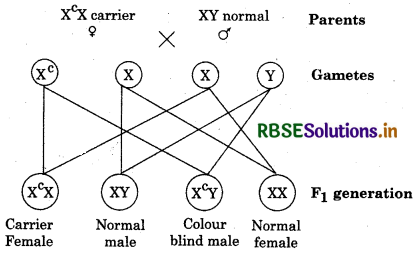
Thus, the sex of colourblind child would be male.
Question 11.
Why did T.H. Morgan select Drosophila melanogaster to study sex-linked genes for his lab experiments.
Answer:
T.H. Morgan preferred fruit fly (Drosophila melanogaster) for his experiments because of the following reasons :
- It has fast and short life cycle.
- It has only four pairs of chromosomes.
- It reproduces quickly.
Question 12.
Give one example of a gene responsible for multiple phenotype expressions. What are such genes called? State the cause that is responsible for such an effect.
Answer:
Pleiotropy is the phenomenon in which a single gene exhibit multiple phenotypic expressions. The gene exhibiting pleiotropy are called pleiotropic genes. Pleiotropism occurs mainly because of mutation in a particular gene, e.g., phenyl ketonuria which is a disorder caused by mutation in the gene coding for the enzyme phenylalanine hydroxylase. In the absence of this enzyme, phenylalanine is not converted into tyrosine and accumulation of phenylalanine takes place. The affected individual shows hair and skin pigmentation and mental problems.
Question 13.
Is a haemophelia in humans a sex - linked or autosomal disorder? Workout a cross in support of your answer.
Answer:
Haemophilia is a sex - linked disorder and more specifically it is X - linked disorder.
If normal parents give rise to haemophilic child, then their genotype should be :
Father : XY (Normal)
Mother : XXh (carrier/non - haemophilic/heterozygous)
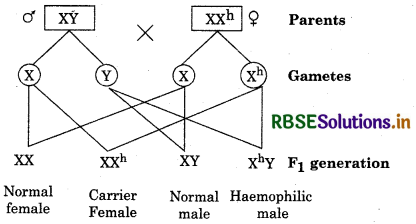
Question 14.
A haemophilic father can never pass the gene for haemophilia to his son. Explain.
Answer:
Haemophilia is a X-linked recessive disease. It is transmitted from the carrier female to her son. The disease is being transmitted from the carrier mother to her daughter (carrier) and son (affected). The carrier daughter transmits this disease to the grandson. This pattern of inheritance is known as criss-cross inheritance.
Question 15.
Write the genotypes of the parents of a child suffering from thalassemia. State the cause of this disease.
Answer:
The genotypes of the parents of a child suffering from thalassemia are as follows :
Mother : ThB ThB+
Father : ThB ThB+
Thalassemia is an autosomal - linked recessive disorder, which results in reduced rate of synthesis of one of the globin chains of haemoglobin. The disease is controlled by a single pair of allele, ThB and ThB+. ThB codes for normal ß-protein and ThB+ codes for an abnormal ß-protein. Only homozygous abnormal individuals for ThB+ (ThB+ ThB+)show the disease phenotype.
Question 16.
Name a disorder a human suffers from as a result of monosomy of the sex chromosome. Give the karyotype and write the symptoms.
Answer:
Monosomy of the sex-chromosome in humans results in Tunner’s syndrome.
The number of chromosomes in affected person is : 44 + X0 = 45.
Symptoms :
- The affected females are sterile as ovaries are rudimentary.
- Other symptoms include lack of secondary sexual characters, short stature etc.
Question 17.
Explain polygenic inheritance with the help of an example.
Answer:
The concept of polygenic inheritance was given by Galton in 1833. In this, traits are controlled by three or more genes (multiple gene). Such traits are called polygenic traits.
For example, human skin colour is produced by a pigment melanin. The quantity of melanin is due to three pairs of polygenes (A, B and C). If a black (AA BB CC) and white (aa bb cc) individuals marry each other, the offspring shows intermediate colour who are often called Mulatt (Aa Bb Cc). A total of eight alleles combinations are possible in the gametes forming 27 distinct genotype.
Short Answer Type Questions - II
Question 1.
Write the cause of Mendels success.
Answer:
The major cause of Mendel’s success was his clear and accurate mathematical analysis of the causes of failure of his antecedent workers. Mendel was able to draw laws or principles. His success can be attributed to the following reasons :
Working Method :
- Mendel studied only one character at a time. When the nature of each character was determined, he studied two characters together and then three.
- Mendel carried out experiments up to the seconed and third generations.
- For study, Mendel selected only two clearly contrasting forms of each character which could easily be identified separately from each other.
- His perfect knowledge of mathematics enabled him to understand the significance of ratio of contrasting characters and to explain laws clearly.
- He maintained the statistical records of all the experiments and analysed them carefully.
- Cross - breeding was done between the parents of pure line.
- The pure lines of parent plants were ascertained by a series of self-crossing tests between progeny of each successive generation.
In spite of all these, Mendel was undoubtedly lucky because :
- None of the characters, selected by him was quantitative.
- Each character was controlled by one factor (now called gene).
- None of the seven characters on which he experimented shown linkage.
Question 2.
Why Mendel select pea plant for his experiment?
Answer:
Mendel had following advantages in his choice of garden pea (Pisum sativum) :
- It is an annual plant and can be grown twice a year. Because of short life span, Mendel was able to study several generations of the plant within a short period.
- It can be easily grown in garden.
- The plant has clearly contrasting characters, whereby characters may easily be divided into separate classes.
- There were several varieties of pea which showed distinct alternative traits.
- The flowers are self-pollinated, the reproductive structures being completely enclosed by petals. This helped Mendel to maintain varieties with same characters, generation after generation.
- The varieties could be artificially cross pollinated. The hybrids thus produced were fertile.
Question 3.
Write the law of dominance with an example on pea plant.
Answer:
When two factors for alternative expression of a trait are brought together by fertilization, only one expresses itself masking the expression of other. The factor that expressed itself was described by mendel as dominant factor and the unexpressed one as recessive factor.
Example : If a cross is made between pure tall pea plant (TT) and pure dwarf pea plant (tt), all plant obtained in F1 generation are tall plants, though these plants contain the factors (Tt) of both the characters. In this case tallness which expressed is dominant character while dwarfness which unexpressed is recessive character.
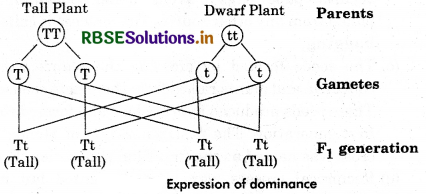
Question 4.
Give the significance of crossing over.
Answer:
Significance of Crossing Over :
- Crossing over leads to new combinations of genes and thus, produce genetic variability in sexual reproducing organisms.
- Variability in population forms the basis of evolution.
- Percentage of crossing over is used in calculating the distance between genes in locating the genes on chromosomes and in determining their sequence.
- Useful recombinations are picked up by plant breeders and animal breeders for developing improved varieties.
- It provides evidence that genes are arranged in a linear order in the chromosomes.
- Chromosome maps are prepared by help of crossing over.

Question 5.
Write the difference between homozygous and heterozygous.
Answer:
Difference between Homozygous and Heterozygous
|
Homozygous |
Heterozygous |
|
1. If the two alleles for a particular character are identical, then it is called homozygous. |
If an organism possesses contrasting alleles, of a pair, it is called heterozygous. |
|
2. Homozygous individuals possess either both dominant or both recessive alleles. |
Heterozygous individuals possess one dominant and one recessive allele. |
|
3. Homozygous individuals may be homozygous dominant or homozygous recessive. |
Heterozygous individuals are only of one type. |
|
4. They are pure for the trait. |
They are not pure for the trait. |
|
5. All gametes produced by homozygous individual are only of one type. |
Two types of gametes are formed. |
|
6. On selfing they produce only one type of offspring. |
Homozygous dominant, homozygous recessive and heterozygous offspring are produced. |
Question 6.
Differentiate between linkage and crossing over.
Answer:
Difference between linkage and crossing over.
|
linkage |
Crossing Over |
|
1. Linkage is the tendency of genes on a chromosome to remain and pass on to the offspring together. |
It is the breaking of the established linkage and formation of new combination of parental gene. |
|
2. It maintains parental combination of genes. |
It forms new combinations. |
|
3. It helps in maintaining a newly improved variety. |
It helps in providing raw material for production of new varieties. |
|
4. Strength of linkage increases as the distance between two linked genes decreases |
Frequency of crossing over decreases with the decreases of distance between genes. |
|
5. It increases with age |
Crossing over occurence decreases with age. |
|
6. It becomes weaker with increase in the distance between genes. |
Increase in distance between genes increases the frequency of crossing over. |
Question 7.
During a monohybrid cross involving a tall pea plant with a dwarf pea plant, the offspring populations were tall and dwarf in equal ratio.
Workout a cross to show how it is possible?
Answer:
In a monohybrid test cross, involving a heterozygous tall plant (Tt) and a pure dwarf plant (tt), the progeny consists of tall and dwarf plants in the ratio of 1 : 1. This can be shown as follows :
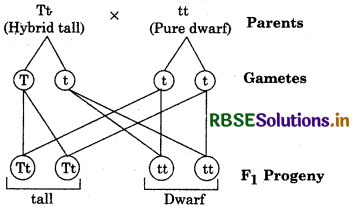
Question 8.
(i) Name the kind of diseases/disorders that are likely to occur in humans if :
(a) mutation in the gene that codes for an enzyme phenylalanine hydrolase occurs,
(b) there is an extra copy of chromosome 21.
(c) the karyotype is XXY.
(ii) Mention any one symptoms of the disease/disorders named above.
Or
Name the kind of diseases/disorders and any two symptoms that are likely to occur in human if:
(i) mutation in the gene that codes for an enzyme phenylalanine hydrolase occur.
(ii) the karyotype is XXY.
Answer:
(i) The following types of diseases are likely to occur in human :
(a) Phenyl ketonuria
(b) Down’s syndrome
(c) Klinefelter’s syndrome
(ii) Symptoms of above diseases are :
(a) Accumulation of phenylketonuria causes mental retardation.
(b) Down’s syndrome : Affected individuals are short statured with small round head.
(c) Klinefelter’s syndrome : The individuals are sterile.
Question 9.
Differentiate between ‘ZZ’ and ‘XY’ type of sex - determination mechanisms.
Or
Explain the mechanism of sex determination in birds. How does it differ from that of human beings.
Answer:
Differences between XY and ZZ types of sex determination are as follows :
|
XY type Sex - determination (in humans) |
ZZ type Sex - determination (in birds) |
|
1. Females are homogametic while males are hetero gametic. |
Females are heterogametic, while males are homogametic. |
|
2. Female produces egg with X - chromosomes only, while male produces sperms with either X or Y- chromosomes. |
Female produces eggs with either Z or W chromosomes, while male produces sperm with Z-chromosomes. |
|
3. Ex. Human, Drosophila. |
Ex. Fish, birds etc. |
Sex determination in humans :
The total number of chromosomes in man is 46 or 23 pairs. Out of which 22 pairs or 44 chromosomes are called autosomes and rest one pair is called sex - chromosomes or allosomes. Autosomes are common to both males and females. The two sex chromosomes are similar in women and are represented by XX. In men, both sex chromosomes are different, one of them is similar to X -chromosomes while the other one is called the Y - chromosome. Therefore, the karyotype of men is 44 + XY and in women is 44 + XX.
Men are heterogametic and produce two types of sperms, 50% having 22+X and other 50% having 22+Y chromosomes. Women are homogametic produce only one type of ova having 22+X chromosomes.
1. In case the ovum is fertilized with a sperm having X-chromosomes, the zygote with 44+XX develop into a female child.
2. When ovum is fertilized with a sperm having 4-chromosome, the zygote with 44+XY chromosomes develops into a male child. Thus, it is clear that:
- The sex of child is determined at the time of fertilization.
- The sex is determined by the genetic make of the sperm.
- There is ahvays 50% probability of a child being born to be male or female.
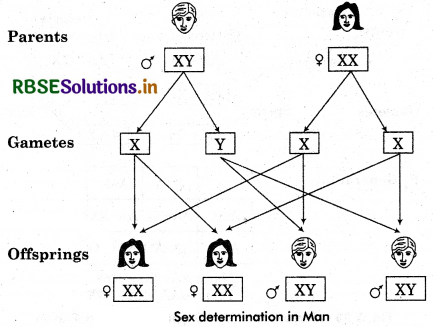
Question 10.
Describe the dihybrid cross experiment performed by Mendel. Explain the law postulated by this experiment.
Answer:
Mendel conducted experiments to study the segregation and transmission of two pairs of contrasting characters at a time. This is called dihybrid cross. He studied the inheritance of round and wrinkled character of seed along with the yellow and green colours of seed coat. Mendel found that a cross between round yellow and wrinkled green seeds (P1) produced only round and yellow seeded plants in F1 generation, but in F2 generation, plants having four type of genotypes were observed. Two of these phenotypes were similar to the parental combinations, while the other two were new combinations.
- Yellow and round seeded - 9 Parental combinations
- Green and round seeded - 3 new combinations
- Yellow and wrinkled seeded - 3 new combinations
- Green and wrinkled seeded - 1 Parental combination
Thus the offspring of F2 generation were produced in the ratio of 9 : 3 : 3 : 1. This ratio is called dihybrid ratio.

Question 11.
Explain the laws that Mendel derived from his monohybrid crosses.
Answer:
According to Mendel’s hypothesis, the gametes combine by chance with certain fixed probabilities. In selfing between plants of F1 generation (all hybrid), both the parents are heterozygous, i.e., have Tt genes. These genes separate in the gametes. Therefore 50% gametes having T and other 50% gametes having t from both parents. During fertilization, male gamete (pollen) with gene T or t may combine with female gamete (ovule) with gene T or t. So the probability of having gene T or t from both male and female gametes is 50% each.
The four possible combinations of genotype are : TT, Tt, tT and tt because :
(i) Gene T from male gamete and gene T from female gamete = TT = 1/4.
(ii) Gene T from male gamete and gene t from female gamete =Tt = 1/4.
(iii) Gene t from male gamete and gene T from female gamete = tT = 1/4.
(iv) Gene t from male gamete and gene t from female gamete = tt = 1/4.
If (ii) and (iii) points considered as Tt then 1/4 + 1/4 = 1/2.
Therefore, F2 ratio of TT : Tt : tt is 1/4 : 1/2 : 1/4, which is equal to 1 : 2 : 1, one homozygous dominant (TT), two heterozygous or hybrid (Tt) and one homozygous recessive (tt).
Question 12.
Although Mendel published his work on inheritance of characters in 1865 but for several reasons, it remained unrecognised till 1900. Explain giving three reasons, why did it take so long.
Answer:
Gregor John Mendel was born in a peasant poor family of Moravia in Czechoslovakia. He received his early education in the village school. Due to poverty, he worked as a priest in the church of Brunn, a town in Austria, now in Czechoslovakia. He was later in 1847, made on abbot (head) of Augustinian monastery of St. Thomas at Brunn. He was honoured by the title of church called Gregor in this very church and thereafter he was known by this name. In 1854, he worked as a teacher. Here, he worked continuously for 14 years along with this he made his famous pea experiments. He conducted his cross-breeding experiments on garden pea (Pisum sativum) in the monastery garden for about nine years from 1854 to 1863 and published his experimental works in the paper entitled Experiments in plant Hybridisation.in an obscure journal Annual Proceedings of the Natural History Society of Brunn in 1865.
Unfortunately, the great significance of Mendel’s discovery was not appreciated by contemporary scientists because :
- He published his results in a journal that had limited circulation.
- Mendel’s concept was for ahead of his time.
- Scientists of that period were ignorant about the cytological basis of heredity.
- Mind of the scientists was pre occupied with the contraversy thrown up by Darwin’s Theory of Origin of Species.
- He was himself not sure of his findings, as he failed to get similar results on Hawkweed (Hieracium).
- Mendel’s concept concluded that the factors which control expression of traits are stable entities and do riot blend with each other was not accepted.
- He used mathematical basis to explain the result of cross-breedings. Use of this basis to explain biological processes was totally new and unacceptable to the scientists of that time.
Mendel died in 1884 of a kidney disorder without knowing that he had laid the foundation of modern genetics. After rediscovery of Mendel’s work ultimatelly he is called the Father of Genetics.
Question 13.
What is a test cross? How can it decipher to heterozygocity of a plant?
Answer:
In mendelian inheritance, the cross between heterozygous F1 hybrid and the double recessive homozygous is known as Test cross. The test cross is used to determine whether the individuals exhibiting dominant character are homozygous or heterozygous. It is also a type of back cross.
For example, when F1 hybrid of red and white coloured flowers (Rr) is crossed with homozygous recessive white (rr) plant, two types of gametes [(R and r)] are produced from F1 hybrid in the same ratio and from white (rr) plant, all same type of gametes (r) are produced on fusion of these gametes, two types of offspring i.e., 50% plants having red coloured flowers and 50% plants having white coloured flowers, are produced. The phenotypic and the genotypic ratio of these is 1 : 1.

Question 14.
Compare in any three ways the chromosomal theory of inheritance as proposed by sutton and Bovery with that of experimental results on pea plant presented by Mendel.
Answer:
On the basis of these points, Sutton and Boveri in 1902, proposed Chromosomal Theory of Inheritance independently. The salient features of this theory are as follows :
- All the somatic cells of an organism are diploid which develop from diploid zygote.
- Each diploid somatic cell has two sets of chromosomes. Out of which one set of chromosomes is received from mother through ovum and the other set from father through sperm.
- The two chromosomes of one type constitute the homologous chromosome pair.
- Each chromosome bears specific determiners or Mendelian factors called genes. These play an important role in the development of an organism from the zygote. Genes are situated in the chromosome in a linear order.
- The chromosomes retain their structural peculiarity, individuality and continuity throughout the life of an organism.
- The behaviour of chromosomes during anaphase of meiosis - I, at the time of gametogenesis, provides evidence that genes are situated in the chromosomes. This also explains the mechanism of segregation and independent assortment of traits at the time of gametogenesis.
Long Answer Type Questions
Question 1.
Explain the law of segregation with suitable example.
Answer:
Mendel explained above results by presuming that :
1. Tallness, and dwarfness are determined by a pair of contrasting factors. A plant is tall because it possesses factors for tallness which is represented by T. A plant is dwarf because it possesses factor for dwarfness which is represented by t. This led to establish the law of unit characters or law of unit factor.
A Danish botanist Johannsen used the term genes for Mendels unit factors in 1909. The American geneticist Morgan in 1912. showed that the genes are on the chromosomes.
2. These factors found in pairs and are known as alleles or allelomorphic pairs. One of them is contributed by each parent.
3. Law of Dominance : When two factors for alternative expression of a trait are brought together by fertilization, only one expresses itself masking the expression of other. The factor that expressed itself was described by mendel as dominant factor and the unexpressed one as recessive factor.
Example : If a cross is made between pure tall pea plant (TT) and pure dwarf pea plant (tt), all plant obtained in F1 generation are tall plants, though these plants contain the factors (Tt) of both the characters. In this case tallness which expressed is dominant character while dwarfness which unexpressed is recessive character.
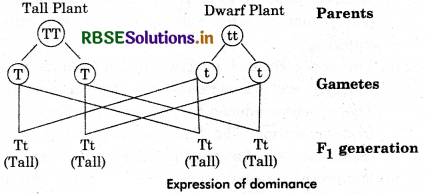
4. Law of Segregation : When theF1 heterozygous plants produce gametes by meiosis, these unit factors segregate and each gamete gets only one of the two alternative factors. It means that the factors for tallness (T) and dwarfness (t) are separate entities and in a gamete, either T or t is present. When F1 hybrids (Tt) are self pollinated, their two types of gamete unite randomly to produce tall and dwarf plants in 3 : 1 ratio.
Example : The law of segregation can be explained by a monohybrid cross. When a cross is made between pure tall plant (TT) and pure dwarf plant (tt) pea plant, in F1 generation only tall pea plants are produced. The genes (factors) of tallness and dwarfness come from parents plants only and they live together without contaminating with eachother. When plants of F1 generation are self pollinated both factor get separated completely in pure form of the time of gamete formation. Each F1 parent gives rise to two types of gamete which fuse together to form two types of plants in F2 generation. Here the ratio between tall plants and dwarf plants is 3 : 1. Tall plants are of two types on the basis of genotype. They are one-third pure or homozygous (TT) and third impure or heterozygous (Tt). The impure or heterozygous plants in F2 generation are again segregated into one - third pure or homozygous plants and two - third impure or heterozygous plants. The pure plants always produce offspring of their own kind.
Such a way, when a pair of two contrasting characters is crossed then in F1 generation they live together without blending. It is the basic principle of Mendel’s inheritance, and these characters get segregated in the forth coming generations (segregation of alleles without mixing in the hybrid).
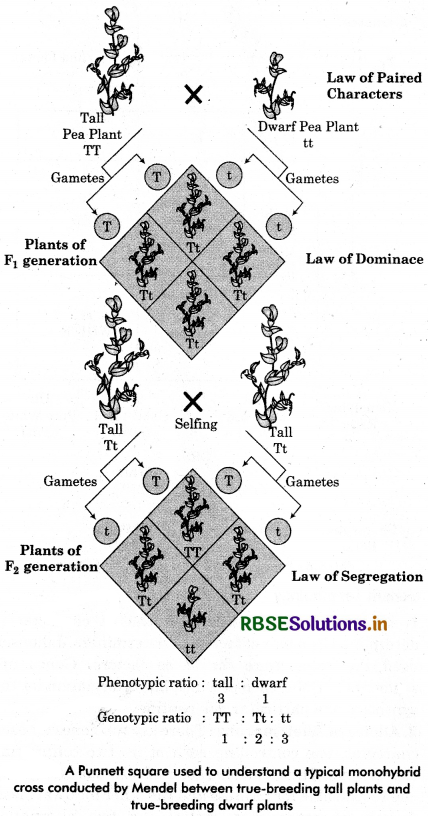
Question 2.
Explain Mendel’s monohybridization experiment. Write the rules proposed on the basis of the experiment. Draw its diagram using punnet square.
Answer:
Mendel first studied the inheritance of a single character at a time. For example, Mendel made a cross between pure tall plant with pure dwarf plant, having a single character, height of plant. A breeding experiment dealing with a single character is called monohybrid cross.
1. F1 Generation : Mendel selected tall (about 100-120 cm) and dwarf (about 22-44 cm) pea plants as parental generation (P). He made hundreds of crosses by transferring the pollen from tall plants to the stigma of dwarf plants and vice versa. When seeds matured on the dwarf plants, he collected and sowed them &nd found that all plants were tall like the parent tall plants. The plants of this generation were called first filial generation (F1 generation).
F2 Generation : The F1 plants were pollinated among themselves or were allowed to undergo self-pollination. The seeds were collected and sown to obtain plants that belonged to Second Filial Generation (F2 generation). The F2 plants were found to contain both tall and dwarf individuals. They were in the ratio of three tall to one dwarf (3 : 1). This indicates that the F1 plants had a trait for tallness as well as a trait for dwarfness. Such genetically mixed offsprings produced by crossing two pure parents having contrasting traits are called hybrids.
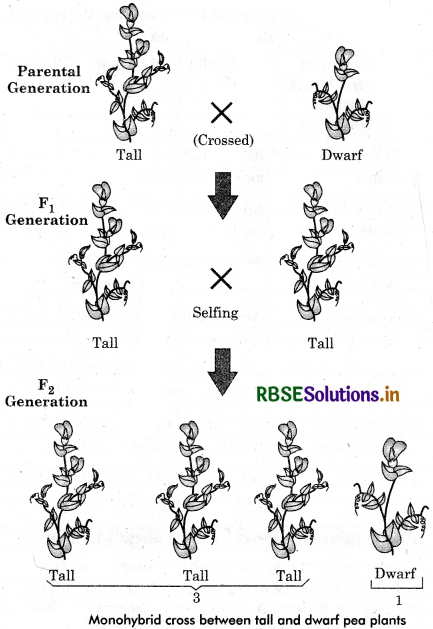
F3 Generation : When F2 plants were allowed self pollination, Mendel obtained following results in F3 generation:
(a) The dwarf plants of F2 generation produced only dwarf plants by self - pollination in subsequent generations.
(b) Among the tall plants of F2 generation, only l/3rd were found to breed true for tallness. The rest 2/3 produced tall and dwarf plants in the ratio of 3 : 1. It means F2 generation considered of three types of plants : (i) 25% tall homozygous (pure), (ii) 50% tall heterozygous and (iii) 25% dwarf homozygous.
Mendel carried out similar experiments up to F2 generation with several other contrasting traits and obtained similar results. Only one trait appeared in Ft while both the traits were expressed in F2 generation in the ratio of 3 : 1. The characters did not show only blending in F1 or F2 generation.

Question 3.
What is co - dominance. Explain it through determination of blood groups in human. Draw a table showing the genetic basis of blood groups in Human population.
Answer:
The alleles which are able to express themselves independently, even when present together are called co - dominant alleles and this biological phenomenon is called co-dominance.
In co - dominance, both the genes of an allelomorphic pair express themselves equally in the F1 hybrids. In F2 generation, their phenotypic ratio matches with the genotypic ratio. Their F2 progeny exhibits 1 : 2 : 1 ratio.
Example 1. Codominance of Coat colours in Cattle : In cattle, gene R stands for red coat colour and W for white colour coat. When red cattle (RR) is crossed with white cattle (WW) the F1 hybrids have roan colour having genotype RW. The roan colour is the mixture of red and white coat which develop side by side in F1 heterozygous organisms. In F2 generation, red, roan and white cattle are produced in the ratio of 1 : 2 : 1. Out of these red and white cattle are homozygous and roan cattle are heterozygous.
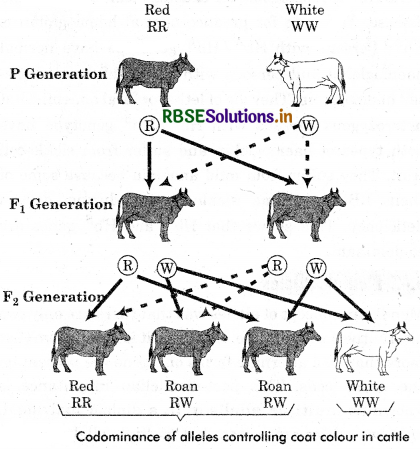
Example 2. Co-dominance of Human Blood Groups :
The alleles IA and IB of human blood groups are said to be co - dominant because both are expressed in the phenotype AB. Each produces its antigen and neither checks the expression of the other.
The plasma membrane of human RBCs have antigens. The formation of antigens is controlled by gene I. The I gene has three alleles IO, IA and IB. Both alleles IA and IB are dominant to allele IO but are themselves co-dominant.
(i) Allele IO does not produce any surface antigen.
(ii) Allele IA produces antigen A.
(iii) Allele IB produces antigen B.
In each individual, any two of the three alleles may he present. Therefore, the following types of genotypes and phenotypes are found in human population.
Example 3. Co - dominance of Sickle Haemoglobin : Gene HbS is responsible for causing sickle cell anaemia disease. The gene for produce normal haemoglobin is HbA. Persons with HbA HbA genotype have normal haemoglobin and persons with HbS/ HbS have sickle - cell haemoglobin. They die of lethal or fatal anaemia, but heterozygous persons with HbA/ HbS genotype have both types of haemoglobin and suffer from sickle-cell trait. They suffer from mild anaemia because some of their RBCs, become sickle-shaped during oxygen deficiency. This shows that HbA and HbS genes are co-dominant.
Question 4.
(i) State and explain the law of segregation as proposed by Mendel in a monohybrid cross.
(ii) Write the Mendelian F2 phenotypic ratio in a dihybrid cross. State the law that he proposed on the basis of this ratio. How is this law different from the law of segregation?
Answer:
(i) Law of Segregation : When the F1 heterozygous plants produce gametes by meiosis, these unit factors segregate and each gamete gets only one of the two alternative factors. It means that the factors for tallness (T) and dwarfness (t) are separate entities and in a gamete, either T or t is present. When F1 hybrids (Tt) are self pollinated, their two types of gamete unite randomly to produce tall and dwarf plants in 3 : 1 ratio.
Example : The law of segregation can be explained by a monohybrid cross. When a cross is made between pure tall plant (TT) and pure dwarf plant (tt) pea plant, in F1 generation only tall pea plants are produced. The genes (factors) of tallness and dwarfness come from parents plants only and they live together without contaminating with eachother. When plants of F1 generation are self pollinated both factor get separated completely in pure form of the time of gamete formation. Each F1 parent gives rise to two types of gamete which fuse together to form two types of plants in F2 generation.
Here the ratio between tall plants and dwarf plants is 3 : 1. Tall plants are of two types on the basis of genotype. They are one-third pure or homozygous (TT) and third impure or heterozygous (Tt). The impure or heterozygous plants in F2 generation are again segregated into one - third pure or homozygous plants and two-third impure or heterozygous plants. The pure plants always produce offspring of their own kind.
Such a way, when a pair of two contrasting characters is crossed then in F1 generation they live together without blending. It is the basic principle of Mendel’s inheritance, and these characters get segregated in the forth coming generations (segregation of alleles without mixing in the hybrid).
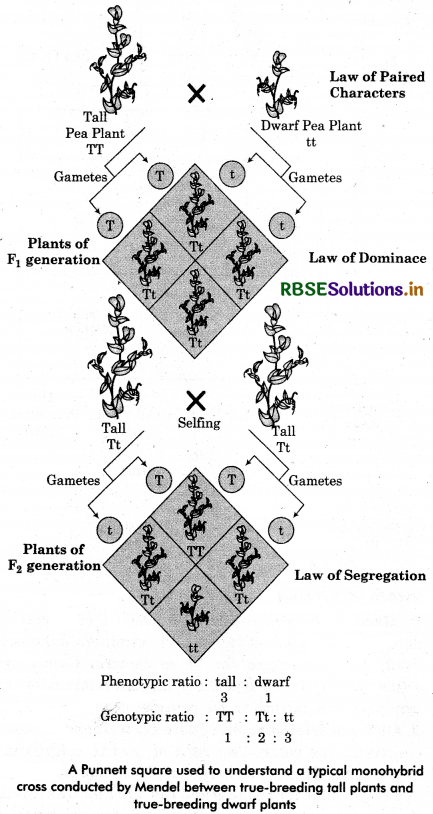
(ii) (a) Mendelian F2 phenotype ratio in a dihybrid cross is 9 : 3 : 3 : 1.
(b) Law of independent assortment was proposed on the basis of dihybrid cross. It states that when two pairs of contrasting traits are combined in a hybrid, segregation of one pair of character is independent of the other pair of characters.
Difference between law of segregation and law of independent assortment are :
|
Law of Segregation |
Law of Independent Assortment |
|
1. It is based on the monohybrid cross. |
It is based on the dihybrid cross. |
|
2. It explains non - mixing at two alleles at a gene at the time of gamete formation. |
It explains non - mixing of characters during their inheritance to the next generation. |
Question 5.
(i) What is polygenic inheritance? Explain with the help of a suitable example.
(ii) How are pleiotropy and Mendelian pattern of inheritance different from pollygenic pattern of inheritance.
Answer:
(i) Pleiotropy is the phenomenon in which a single gene exhibits multiple phenotypic expressions. It means that a single pleiotropic gene may produce more than one effect.
The pleiotropic effect is produced by a gene owing to a cascade of reactions during some metabolic pathway which are influenced from the original gene product and contribute to different phenotypic effects.
Example: Phenyl Ketonuria (PKU): Phenyl ketonuria is an autosomal recessive character. It is controlled by a mutant gene present on 12th chromosome. The mutant gene fails to code for the enzyme phenylalanine hydroxylase (PAH). This enzyme is required for the normal metabolism of amino acid phenylalanine to tyrosine. This results in the accumulation of phenylalanine in the body fluids like blood, sweat and cerebrospinal fluid and appearance of an abnormal breakdown product phenylketone in urine. Accumutated phenylalanine and breakdown products cause severe brain damage leading to mental retardation. Such persons are fair-skinned with blonde hair and blue eyes because of failure of melanin synthesis in skin.
(ii) In pleiotropy, single gene product may produce multiple or more than one phenotypic effect whereas in polygenic inheritance single phenotypic trait (human skin colour) is controlled by 3 pairs of genes (A, B and C).
Question 6.
State and explain the “law of independent assortment” in a typical Mendelian dihybrid cross.
Answer:
When crosses are made between plants with two or more than two contrasting characters, the inheritance of these characters occurs independently i.e., the inheritance of one character does not affect the inheritance of other characters.”
Experiment : Mendel took into consideration shape of seed and colour of the seeds. He crossed a pea plant having round and yellow seeds with a pea plant having wrinkled and green seeds. All the plants of F1 generation had round and yellow seeds. F1 plants on selling, produced four kinds of plants in F2 generation.
Explanation : Mendel represented :
1. Gene for yellow colour of seeds - Y
2. Gene for green colour of seeds - y
3. Gene for round shape of seeds - R
4. Gene for wrinkled shape of seeds - r
Therefore, plants with round and yellow seeds will have their genotype RRYY and those with wrinkled and green seeds will have the genotype rryy. These plants will produce gametes with genes RY and ry respectively. When these parents plants are crossed, the union of gametes will produce F, hybrid with RrYy genotype.
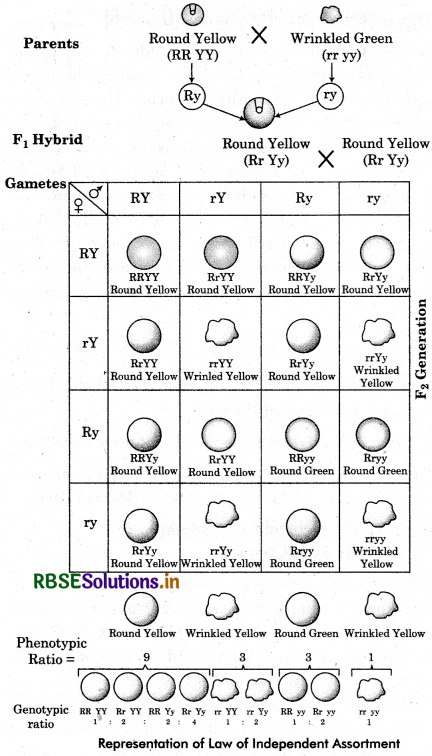
Mendel explained the results by assuming that the round and yellow characters are dominant over wrinkled and green so that all F1 offspring are round yellow. In F2 generation all the four type of genes assort out independent of the others. It means a pair of alternate or contrasting characters behave independently of the other pair, i.e., inheritance of seed shape is independent of seed colour. Therefore at the time of gamete formation, genes for round or wrinkled character of seed assorted out independently of the yellow or green colour of the seed. As a result from the F1 hybrid, four type of gametes were formed with two types of gametes having parental combination of genes and two types of gametes having new combinations. These are RY, rY, Ry and ry. These four types of gametes on random fusion produced four types of offspring in the ratio of 9 : 3 : 3 : 1 in F2 generation.
In F2 generation :
1. Plants having round and yellow seeds = 9
2. Plants having wrinkled and yellow seeds = 3
3. Plants having round and green seeds = 3
4. Plants having wrinkled and green seeds = 1
Conclusion : According to law of independent assortment, when inheritance of two pairs of characters is studied simultaneously inheritance of one pair of characters is not influenced by the inheritance of second pair of characters.

Question 7.
(i) Write the scientific name of the organism Thomas Hunt Morgan and his colleagues worked with for their experiment.
Explain the correlation between linkage and recombination with respect to genes as studied by them.
(ii) How did Sturtevant explain gene mapping while working with Morgan?
Answer:
(i) Large number of genes are found in each species to produce its various characters. The number of genes is from thousands to lakhs while the number of chromosomes is constant and limited. Hence, it is ovious that each chromosome bears many genes. Therefore, all the genes located in the same chromosome will behave as a unit during meiosis and are inherited together. Therefore, they do not follow independent assortment as seen in case of genes present on nonhomologous chromosomes. Genes located on the same chromosome tend to be inherited together. This phenomenon of inheritance of genes together and retain parental combination in the offspring is called linkage. The genes located in the same chromosome and being inherited together are known as linked genes and the characters controlled by them are called linked characters.
Linkage Group : All the genes located in a single chromosome form one linkage group. The total number of linkage group in an organism corresponds to the haploid number of chromosomes, i.e., to the number of chromosomes pairs. For instance Drosophila melanogaster has 4, Garden pea 7, Maize 10 and Man has 23 linkage groups.
Morgan's Concept of Linkage :
Morgan et. all, (1910), while working on Drosophila melanogaster noted that genes located on the same chromosome produce more parental combination than the nonparental (new) combinations. Morgan concluded that coupling and repulsion phenomenon of genes are two aspects of linkage. He defined linkage as the tendency of genes present in the same chromosome to retain in their original combination and to enter together in the same gamete.
Salient features of Theory of Linkage :
- The genes are arranged in a linear order in the chromosome.
- Linked genes are situated in the same chromosome.
- Linked genes tend to remain in their original combination during the course of inheritance.
- The genes which are closely situated show strong linkage, while those widely separated, have more chance to get separated by crossing over.
Cis and Trans Arrangement of Linked Gene :
In heterozygous organisms, the linked genes can show two types of arrangements :
1. cis arrangement : When the dominant alleles of two or more pairs of linked genes are present on one chromosome and their recessive aelleles on the other homologous (AB/ab), this arrangement is known as cis arrangement.
2. Trans arrangement : WTien the dominant allele of one pair and recessive allele of the second pair are present on one chromosome and recessive and dominant alleles on the other homologous chromosome of a pair (Ab/aB), this arrangement is known as trans arrangement.
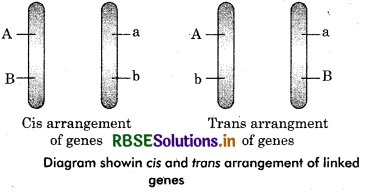
(ii) Sturtevant, a student of Morgan, used the frequency of recombination between the gene pair on the same chromosomes as a measure of the distance between genes. He mapped the position of genes on the chromosome by using this information.
Question 8.
Differentiate between incomplete dominance and co-dominance. Substantiate your answer with one example of each.
Answer:
Difference between Co-dominance and Incomplete dominance.
|
Co - dominance |
Incomplete Dominance |
|
1. It is the appearance of both parental phenotypes togethere in the offspring when a cross is made between individuals with two different phenotypes. |
It is the appearance of an intermediate phenotype, which is a combination of both parental alleles when a cross is done between individuals with two different phenotypes. |
|
2. Both parental alleles produce their effect independently. |
Effect of the two parental alleles is intermediate on the offspring. |
|
3. Both parental alleles can be observed in the offspring. |
None of parental alleles can be observed in the offspring. |
|
4. Example : ABO blood group etc., six different genotypes of human ABO blood group show four phenotypes : A, B, AB and O. |
Example : |
